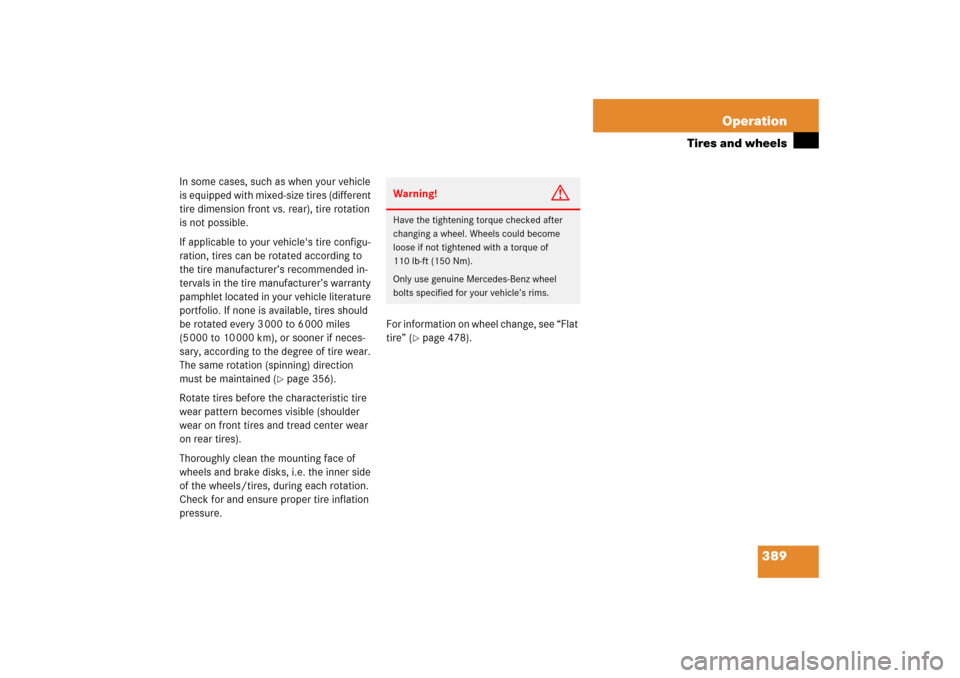Page 390 of 561

389 Operation
Tires and wheels
In some cases, such as when your vehicle
is equipped with mixed-size tires (different
tire dimension front vs. rear), tire rotation
is not possible.
If applicable to your vehicle's tire configu-
ration, tires can be rotated according to
the tire manufacturer’s recommended in-
tervals in the tire manufacturer’s warranty
pamphlet located in your vehicle literature
portfolio. If none is available, tires should
be rotated every 3 000 to 6 000 miles
(5 000 to 10 000 km), or sooner if neces-
sary, according to the degree of tire wear.
The same rotation (spinning) direction
must be maintained (
�page 356).
Rotate tires before the characteristic tire
wear pattern becomes visible (shoulder
wear on front tires and tread center wear
on rear tires).
Thoroughly clean the mounting face of
wheels and brake disks, i.e. the inner side
of the wheels/tires, during each rotation.
Check for and ensure proper tire inflation
pressure.For information on wheel change, see “Flat
tire” (
�page 478).
Warning!
G
Have the tightening torque checked after
changing a wheel. Wheels could become
loose if not tightened with a torque of
110 lb-ft (150 Nm).
Only use genuine Mercedes-Benz wheel
bolts specified for your vehicle’s rims.
Page 486 of 561

485 Practical hints
Flat tire
�
Detach the electric air pump.
�
Store the electrical plug and the air
hose behind the flap and place the
electric air pump back in the vehicle
tool kit storage well.Lowering the vehicle
�
Lower vehicle by turning crank coun-
terclockwise until vehicle is resting ful-
ly on its own weight.
�
Remove the jack.
1-5Wheel bolts6Wheel wrench
�
Tighten the five wheel bolts evenly, fol-
lowing the diagonal sequence illustrat-
ed (1 to 5), until all bolts are tight.
Observe a tightening torque of
110 lb-ft (150 Nm).
Warning!
G
Follow recommend tire inflation pressures.
Do not overinflate tires. Overinflating tires
can result in sudden deflation (blowout) be-
cause they are more likely to become punc-
tured or damaged by road debris, potholes,
etc.
Do not underinflate tires. Underinflated tires
wear unevenly, adversely affect handling
and fuel economy, and are more likely to fail
from being overheated.
Warning!
G
Inflate collapsible tire only after the wheel is
properly mounted.
Inflate the collapsible tire using the electric
air pump (
�page 483) before
lowering the
vehicle.
Warning!
G
Have the tightening torque checked after
changing a wheel. The wheels could come
loose if they are not tightened to a torque of
110 lb-ft (150 Nm).
��
Page 534 of 561

533 Technical terms
Program mode selector switch
Used to switch the automatic transmis-
sion between standard operation (S)
and comfort operation (C).
PSI
(P
ounds p
er s
quare i
nch)
(
�page 387)
Recommended tire inflation pressure
(�page 387)
REST
(Residual E
ngine H
eat U
tilization)
Feature that uses the engine heat
stored in the coolant to heat the vehi-
cle interior for a short time after the en-
gine has been turned off.
Restraint system
Seat belts, belt tensioner, air bags and
child seat restraint systems. As inde-
pendent systems, their protective func-
tions complement one another.
Rim
(
�page 387)RON
(R
esearch O
ctane N
umber)
The Research Octane Number for gaso-
line as determined by a standardized
method. It is an indication of a gaso-
line's ability to resist undesired detona-
tion (knocking). The average of both
the ->MON (Motor Octane Number)
and RON (Research Octane Number) is
posted at the pump, also known as
ANTI-KNOCK INDEX.
Sidewall
(
�page 387)
SRS
(Supplemental R
estraint S
ystem)
Seat belts, emergency tensioning de-
vice and air bags. Though independent
systems, they are closely interfaced to
provide effective occupant protection.Tele Aid System*
(T
elematic A
larm I
dentification on
D
emand)
The Tele Aid system consists of three
types of response: automatic and man-
ual emergency, roadside assistance
and information. Tele Aid is initially ac-
tivated by completing a subscriber
agreement and placing an acquain-
tance call.
The Tele Aid system is operational pro-
vided that the vehicle’s battery is
charged, properly connected, not dam-
aged and cellular and GPS coverage is
available.
Telematics*
A combination of the terms “telecom-
munications” and “informatics”.
Tightening torque
Force times lever arm (e.g. a wheel
wrench) with which threaded fasteners
such as wheel bolts are tightened.
Page 555 of 561

554 Index
Opening from the outside 122
Unlocking and opening with
KEYLESS-GO* 120
Unlocking with SmartKey 114
Tar stains 396
Technical data 523
Brake fluid 523
Coolants 525
Electrical system 518
Engine 513
Engine oil 523
Engine oil additives 523
Fuel requirements 524
Gasoline additives 525
Main dimensions 519
Premium unleaded gasoline 524
Rims and tires 514
Weights 520
Windshield washer and headlamp
cleaning* system 528
Tele Aid System* 533Tele Aid* 311
Call priority 318
Emergency calls 313
Information 317
Initiating an emergency call
manually 314
Messages in display 450, 451
Remote door unlock 319
Roadside assistance 315
Stolen vehicle recovery services 319
System self-check 312
Telematics* 533
Telephone* 310
Answering a call 195
Dialing a number from the phone
book 195
Ending a call 195
Loading phone book* 195
Messages in the display 451
Operating 194
Redialing 196
Temperature
Setting interior temperature 222,
236
Tires 364
Third-row sunshade* 2143-zone automatic climate control* 230
Ticket holder 300
Tie-down rings (Cargo
compartment) 281
Tightening torque 533
Tightening torque (Wheel bolts) 485
Tilt
Head restraint 45
Tilt/sliding sunroof*
Closing 255
Opening 255
Synchronizing 258
Time
Setting day 181
Setting hours 180
Setting minutes 180
Setting month 181
Setting year 181
TIN 387, 534
Tire
Vehicle maximum load on 388
Tire and Loading Information 357
Tire and loading terminology 385
Tire care and maintenance 354
Tire Identification Number see TIN